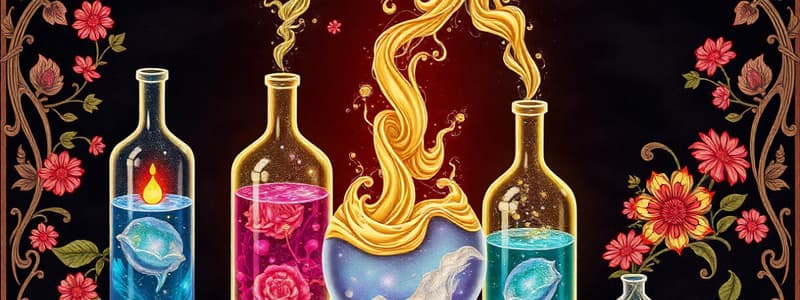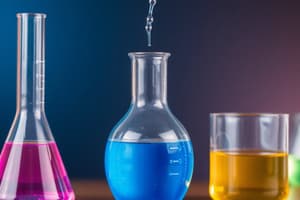Podcast
Questions and Answers
What happens when milk is left at room temperature during summers?
What happens when milk is left at room temperature during summers?
The milk undergoes a chemical change and spoils.
What happens to an iron tawa/pan/nail when it is left exposed to a humid atmosphere?
What happens to an iron tawa/pan/nail when it is left exposed to a humid atmosphere?
It rusts due to the reaction with moisture in the air.
What do grapes undergo when they get fermented?
What do grapes undergo when they get fermented?
They undergo a chemical change to produce alcohol.
What happens to food when it is cooked?
What happens to food when it is cooked?
What happens to food during digestion in our body?
What happens to food during digestion in our body?
What happens when we respire?
What happens when we respire?
Which of the following observations indicates a chemical reaction has taken place? (Select all that apply)
Which of the following observations indicates a chemical reaction has taken place? (Select all that apply)
What is formed when magnesium is burned in air?
What is formed when magnesium is burned in air?
What is the word-equation for the reaction between magnesium and oxygen?
What is the word-equation for the reaction between magnesium and oxygen?
What are the reactants in the equation for the reaction of magnesium and oxygen?
What are the reactants in the equation for the reaction of magnesium and oxygen?
Study Notes
Chemical Reactions and Changes
- Chemical reactions occur when the identity and nature of a substance change.
- Daily life examples include milk spoiling, rust on iron, fermentation of grapes, cooking, digestion, and respiration.
- It's essential to differentiate between physical changes (no new substance) and chemical changes (new substance formed).
Indicators of Chemical Reactions
- The occurrence of a chemical reaction can be identified by:
- Change in state (solid, liquid, gas).
- Change in color.
- Evolution of gas (bubbles).
- Change in temperature (exothermic or endothermic reactions).
Activities Demonstrating Chemical Reactions
-
Activity 1.1: Burning Magnesium
- A magnesium ribbon (3-4 cm) is cleaned and then burned to produce magnesium oxide, an observation of shiny combustion.
- The reaction between magnesium and oxygen creates a white powder (magnesium oxide).
-
Activity 1.2: Lead Nitrate and Potassium Iodide
- Mixing lead nitrate with potassium iodide in a test tube leads to the formation of a yellow precipitate, indicating a chemical reaction.
-
Activity 1.3: Zinc with Acid
- Zinc granules reacting with dilute hydrochloric or sulfuric acid raises the temperature of the solution and produces hydrogen gas.
Chemical Equations
- Chemical reactions can be represented in a concise manner using word equations.
- For example, the conversion of magnesium and oxygen into magnesium oxide is represented as:
- Word Equation: Magnesium + Oxygen → Magnesium Oxide
- In chemical reactions, reactants are the substances initially involved, while products are the substances formed after the reaction.
Studying That Suits You
Use AI to generate personalized quizzes and flashcards to suit your learning preferences.
Description
Test your understanding of chemical reactions and the changes substances undergo. This quiz covers indicators of reactions, examples from daily life, and various activities demonstrating these concepts. Gain insight into the differences between physical and chemical changes.




